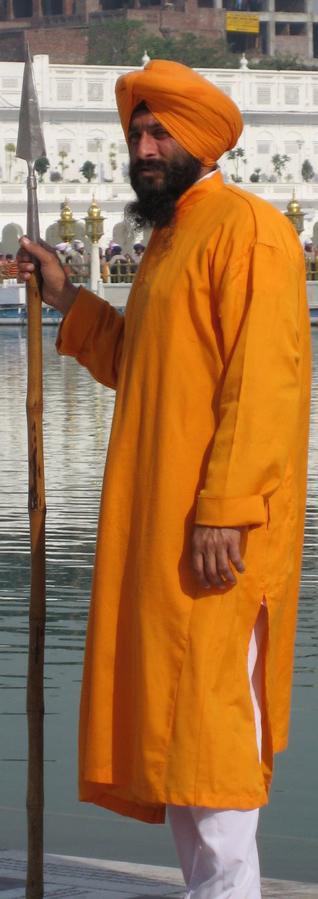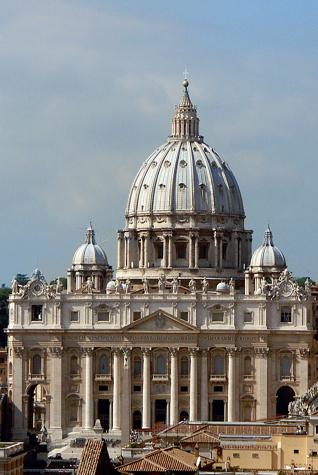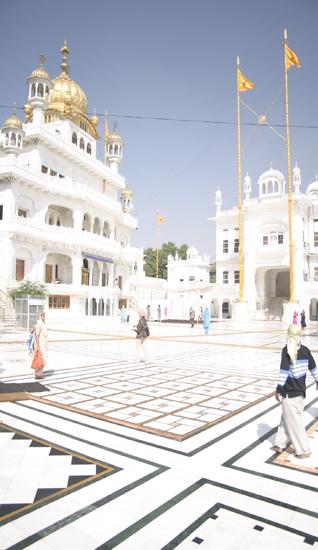Columnists
En Garde: The Vatican & The Akal Takht
by I.J. SINGH
In this season, Passover, Easter and Vaisakhi speak to us and our neighbors. These high holidays come at about the same time every year and remain defining days for Jews, Christians and Sikhs.
This year, however, Easter and Vaisakhi present some unusual but significant lessons for Christians and Sikhs - it has become a time that calls for some reflection and a sobering inward look.
For centuries, but particularly for the past decade or so, an ever increasing storm has been buffeting the Roman Catholic Church.
For the five years since he became the Pope, Benedict XVI has found little peace from the sexual scandal swirling around him. Under the lens is his time as Joseph Ratzinger, the Archbishop in Germany, and later as head of the Congregation for the Doctrine of the Faith that had overall responsibility for such cases starting in 2001.
That "To err is human" is a universally understood truism but not to the average Christian when applying it the Pope. The Pope's words carry infallible authority when he speaks from the Chair of Saint Peter on matters of faith and morals. He is the visible head of the mystical body of Christ.
To question him or to cast aspersions on his conduct "is to attack the church universal," says the Rev. James Martin, the Jesuit culture-editor of America, a Roman Catholic Weekly magazine. Martin continues that "Over the past 100 years the office of the Pope has taken on greater stature and importance for the average Catholic."
I personally found it unnecessarily preachy, even offensively galling, that in his annual message "Urbi et Orbi" -- To the City and To The World" - delivered from the balcony of the Vatican this year, the Pope never once mentioned the sexual scandals that have just about ripped apart the Catholic world. But he did touch upon the many trials facing the world: conflict in the Middle East, drug trafficking in Latin America, earthquakes in Haiti and Chile, the fate of Christians in Iraq and Pakistan, even the raging conflicts in Africa.
All I can say to this is to cite Shaikh Farid from the Guru Granth; his words exhort us to use our intelligence not to explore the shortcomings of others but to look within ourselves -'Jay too akal lateef kaalay likh naa lekh/ apnay gareeban sio(n) sir neeva(n) kar vekh'.
The Pope's words seemed to me akin to burying one's head in the sand, particularly since the Catholic hierarchy, like any efficient bureaucracy, has circled the wagons and almost united in condemnation and rejection of any criticism.
And then I couldn't resist thinking about the travails of the Akal Takht, largely representing the seat of temporal authority in Sikhi.
But before I go further, let me make one thing perfectly clear - that the Akal Takht is not the Vatican; its head (Jathedar) is not the Pope. The Roman Catholic version of a pyramidal hierarchy with its inherent ecclesiastical authority was never the model of governance in Sikhi and, I fervently hope, never will be, even though I have seen Sikhs and the media erroneously drawing parallels between the two.
The current fanning of the flames on and about the Akal Takht seems to have started from the episode(s) involving Prof. Darshan Singh with some fuel to the fire being added by the conflict around the playwright Gurpreet Kaur Bhatti, the author of "Behzti" and "Behud."
But we have a longer history to this - from the excommunication and shunning of Teja Singh (Bhassaur), Professor Gurmukh Singh, Gurbaksh Singh Kala Afghana, among others, as well as the visiting of sundry punishment to Maharaja Ranjit Singh, Surjit Singh Barnala, Buta Singh, Pashaura Singh, and many others. This list is, at best, incomplete.
Now we have a flash fire burning, destroying good people in its wake. The current case of Darshan Singh seems to have polarized the worldwide Sikh community as nothing has in the past. (I do not write to defend or attack Darshan Singh here; that's absolutely not my purpose today.)
The reason may lie in the near iconic status that Darshan Singh has enjoyed over many decades, stemming from his kirtan and discourses, and also because many Sikhs now view the current Akal Takht as a bureaucratic reality with little independence, sagacity or credibility.
This does not mean at all that there are no defenders left of the Akal Takht and what they see as the historical authenticity of its authority. This does not disturb me quite so much. History shows a cyclical path with an ebb and flow in the fates of men and institutions. Time has a way of working out the mazes and complications in our lives, as long as we keep after the problems with honesty of purpose and openness of heart.
Those that seemingly want to wipe the Akal Takht out of existence, I think, are bent on biting off their nose to spite their face. Their anger and frustration are righteous but are not productively channeled. They remind me of those who want to destroy the Church, as some defenders of the Church allege. The obverse side of the coin has those who want to destroy the critics of the Church turning a blind eye to the sins and failings of those acted in the name of the Church.
The so called "defenders of the faith" are equally blind. They see any questioning of the Church or the Akal Takht as an attack on the fundamentals that has to be resisted with all and every weapon in their arsenal.
Both the defenders and attackers of the Akal Takht remind me of the troubles of the Roman Catholic Church today. Militants both - not fundamentalists, but extremists both. We need them both so that the issue will not die but the solution is not what either side has.
The Catholic Church has now begun to fight and mount an aggressively vigorous defense that minimizes its own failings. In labeling its critics ant-Christian or anti-Church there is an element of denial of its own sins.
I see a similar strain in the knee-jerk defense of the arbitrary procedural policies of the Akal Takht. The critics of the Church are not anti-Christian, nor are the critics of Akal Takht anti-Sikh.
Whether it is the Roman Catholic Church that is under the microscope or the Akal Takht, we don't want to throw away the baby with the bath water; we also don't want to batten the hatches, close our ranks and flame out those who disagree with us.
What troubles me is that the community is roiled so much that all civility has been lost. I know that the path ahead is cluttered with potholes, but the fog of rudeness only makes the way forward harder to see.
Diarmuid Martin, the Archbishop of Dublin that continues to be rocked by sexual scandals of the Church, asks us to see that "...the truth will set the church free, even if the truth is hard to digest."
Guru Granth reminds us: "Such sabhna hoi daroo paap kadhhe dhoye" - meaning that truth is the panacea that will free us of our sins.
April 7, 2010
Conversation about this article
1: Sangat Singh (Kuala Lumpur, Malaysia), April 07, 2010, 10:05 AM.
It seemed like a lull before the storm when, I didn't see any erudite offerings emanating from Dr. I. J. Singh ji, not even a word nor a pithy comment. I thought his nose must be to the grindstone, polishing some precious stone. I wasn't wrong. In the mid-sixties we had the pleasure of Dr. Ganda Singh ji's company when he stayed with us for a week. The Sikh Naujawan Sabha Malaysia had just come into being, and we had invited him as the first eminent personage to grace the occasion. In the evenings, we would mill around him and listen with rapt attention to his wonderful stories. The one that sticks in my mind to this day was in connection with the bravery of Sikhs in the European theatre during World War I, when Dr. Ganda Singh himself was a soldier. If I am not mistaken, he ascribed this nugget to the Kaiser about the gallantry of Sikhs, despite being led by English officers: "An army of lions, led by asses!" he is reported to have said. This brings us to the Akal Takht, then and what it is today. It was, I think, in 1733 or thereabout when, the Mughals, at the instance of Zakaria Khan, finally realized that it was better to make peace with the Khalsa, realizing that "If you can't beat them, join them". They sent a Sikh - I think his name was Subhag Singh - then of their diplomatic corp, to offer a title of Nawab, together with the usual articles that go with it. The first instant, the snap reaction was the usual Khalsa response of a flat 'No' and they spurned the offer by saying 'We are born Sardars and need no such Nawabi shababi!" But the Sikh emissary humbly offered a solution. Yes, indeed this nawabi had no meaning for the great Khalsa, but acceptance might usher in a period of relative peace. 'Make one of your tahlus to accept this title.' This somewhat appealed to them when their eyes fell on Kapur Singh, then engaged in some sewa. 'Tahal mahal taa ka-o milai jaa ka-o saadh kirpal' - He alone obtains the Lord's service and the mansion of His Presence unto whom the Holy Saint is compassionat [GGS:244.16]. He was selected for this honour despite his great reluctance and was invested with the usual shawl, a turban, a jewelled plume, gold bangles and a sword. Bhai Kapur Singh looked magnificent in his new regalia but lost none of his humility, with a request that he should not be deprived of his old privilege of serving in the Guru's kitchen. This was the Akal Takht then. Today, it is no different from the Vatican today. This is no company to be proud of.
2: Gurjender Singh (Maryland, U.S.A.), April 07, 2010, 12:05 PM.
This is the time when neither the Vatican nor the Akal Takhat is following its real duties. I will request I.J. Singh ji, please provide any example when Akal Takht had issued any hukumnana before Maharaja Ranjit Singh and after Guru Govind Singh or during the time of any of the Gurus. Looks to me, as more and more years are pass by, hukamnamas are getting more politically oriented.
3: Jodh Singh, Arora (Jericho, New York, U.S.A.), April 07, 2010, 12:30 PM.
It is improper to compare the positions of the Jathedar of the Akal Takht with the Pope, because one is hand-picked by politicians and the other is elected by a host of senior priests from around the world. Unfortunately today, the jathedar - contrary to Sikh principles, history and traditions - makes his decision and issues edicts as per the advice of the his political boss(es) even though he professes that he is so doing in collaboration with the other four jathedars. The pope makes his decisions in consultation with his advisers who are Christian scholars. It is true that both are facing serious problems in their respective religions. It is their responsibility to find a just and truthful solution. Ad a quick story: a senior Christian priest, after his retirement, told me that his qualification for the job on initiation were education and a recommendation by his family's landlord, who was particularly influential. After that, he said, he moved up the ladder, step by step, as long as he avoided dealing with common folks!
4: I.J. Singh (New York, U.S.A.), April 07, 2010, 5:55 PM.
Gurjender ji: The issue is not how many Hukamnamas were issued and when, or whether they are legitimate or not. These are excellent questions on how the role of the Akal Takht evolved and changed with time but not in this column. I have discussed some of your concerns in earlier essays. Please do look at previous columns on sikhchic.co. I am sure we can revisit such questions at another date. Jodh Singh Arora ji, I am not comparing the roles of the Pope and the Jathedar of the Akal Takht. In fact, I clearly state that "... let me make one thing perfectly clear - that the Akal Takht is not the Vatican; its head (Jathedar) is not the Pope. The Roman Catholic version of a pyramidal hierarchy with its inherent ecclesiastical authority was never the model of governance in Sikhi and, I fervently hope, never will be, even though I have seen Sikhs and the media erroneously drawing parallels between the two." Again, the question here that I am focusing on is not the authority or role of each but how bureaucracies that have vested interest in an issue come together and close ranks to reject any criticism that comes on their plate. I am exploring the common threads in the behavior of these two powerful institutions - and they end up dividing the people by their own close-minded reaction to criticism.
5: Gur Singh (Boston, U.S.A.), April 07, 2010, 9:44 PM.
The greatest paradox that our kids might end up facing tomorrow, would be the fact that Sikhi ended up creating one more Vatican while fighting the existing ones. There is an utmost need to redefine the role of the Akal Takht and make it conform its spirit with the gurgaddi of Guru Granth Sahib, as compared to its authority during the reign of the Gurus VI to X.
6: Gursharan Singh Toor (Canada), April 08, 2010, 6:47 PM.
Excellent article. Well balanced. Properly worded. Constructive. This writer knows how to think calmly, express lucidly and suggest solutions like a soothing balm on the painful spots.






